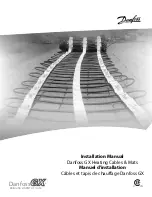
Turn your face to one side when opening the valve of a shielding gas cylinder.
Close the shielding gas cylinder valve if no welding is taking place.
If the shielding gas cylinder is not connected, leave the valve cap in place on the
cylinder.
The manufacturer's instructions must be observed as well as applicable national
and international regulations for shielding gas cylinders and accessories.
Danger from es-
caping shielding
gas
Risk of suffocation from the uncontrolled escape of shielding gas
Shielding gas is colourless and odourless and, in the event of a leak, can displace
the oxygen in the ambient air.
-
Ensure an adequate supply of fresh air with a ventilation rate of at least
20 m³/hour.
-
Observe safety and maintenance instructions on the shielding gas cylinder or
the main gas supply.
-
Close the shielding gas cylinder valve or main gas supply if no welding is tak-
ing place.
-
Check the shielding gas cylinder or main gas supply for uncontrolled gas
leakage before every start-up.
Safety measures
at the installa-
tion location and
during transport
A device toppling over could easily kill someone. Place the device on a solid, level
surface such that it remains stable
-
The maximum permissible tilt angle is 10°.
Special regulations apply in rooms at risk of fire or explosion
-
Observe relevant national and international regulations.
Use internal directives and checks to ensure that the workplace environment is
always clean and clearly laid out.
Only set up and operate the device in accordance with the degree of protection
shown on the rating plate.
When setting up the device, ensure there is an all-round clearance of 0.5 m (1 ft.
7.69 in.) to ensure that cooling air can flow in and out freely.
When transporting the device, observe the relevant national and local guidelines
and accident prevention regulations. This applies especially to guidelines regard-
ing the risks arising during transport.
Do not lift or transport operational devices. Switch off devices before transport
or lifting.
Before transporting the device, allow coolant to drain completely and detach the
following components:
-
Wirefeeder
-
Wirespool
-
Shielding gas cylinder
After transporting the device, the device must be visually inspected for damage
before commissioning. Any damage must be repaired by trained service techni-
cians before commissioning the device.
16
Summary of Contents for Pull
Page 2: ......
Page 21: ...System configurations 21...
Page 22: ...22...
Page 41: ...System components 41...
Page 42: ...42...
Page 56: ...OPT CAM Prepared for the camera recording option 56...
Page 67: ...Controls connections and mechan ical components 67...
Page 68: ...68...
Page 85: ...Assembling system components conventional robot 85...
Page 86: ...86...
Page 91: ...3 3 Nm 2 43 lb ft 2 6 Nm 4 43 lb ft 3 91 EN...
Page 95: ...Optimum hosep ack arrangement R R R 200 mm R 200 mm 95 EN...
Page 102: ...102...
Page 103: ...Assembling system components PAP robot 103...
Page 104: ...104...
Page 107: ...Fitting the SplitBox SB 500i R PAP Fitting the SB 500i R PAP 1 2 107 EN...
Page 110: ...4 Nm 2 95 lb ft 2 8 Nm 5 90 lb ft 3 110...
Page 112: ...11 Nm 8 11 lb ft 5 Fitting the WF Robacta Drive to the robot PAP 1 1 2 112...
Page 113: ...3 42 0411 1315 BY2 0201 4896 4 18 Nm 13 28 lb ft 5 113 EN...
Page 114: ...6 114...
Page 117: ...3 4 117 EN...
Page 118: ...118...
Page 119: ...Assembling further system com ponents 119...
Page 120: ...120...
Page 128: ...2 128...
Page 131: ...Steel inner liner 1 2 3 131 EN...
Page 134: ...Fitting the OPT i camera mount 1 2 3 4 134...
Page 137: ...5 6 Fitting the inner liner unreeling wirefeeder wire buffer 1 2 137 EN...
Page 138: ...3 4 5 Fitting the inner liner SplitBox WF 25i with in ternal inner liner 1 138...
Page 143: ...Start up 143...
Page 144: ...144...
Page 148: ...5 6 7 8 Torx 40 1 Nm 0 74 lb ft 9 10 148...
Page 150: ...5 12 mm 42 0411 0160 6 7 8 12 mm 5 Nm 3 69 lb ft 42 0411 0160 2 9 10 150...
Page 151: ...2 1 11 12 151 EN...
Page 156: ...156...
Page 157: ...Troubleshooting maintenance and disposal 157...
Page 158: ...158...
Page 168: ...3 4 Inserting the inner liner 1 2 3 4 168...
Page 173: ...Removing the CrashBox PAP from the robot 1 BY2 0201 4896 2 3 4 5 1 6 173 EN...
Page 175: ...Technical data 175...
Page 176: ...176...
Page 181: ...Triggering torques and weight distance diagram 181 EN...
Page 188: ...The product conforms to the requirements of the IEC 60974 7 standard ED Duty cycle 188...
Page 195: ...195 EN...
















































